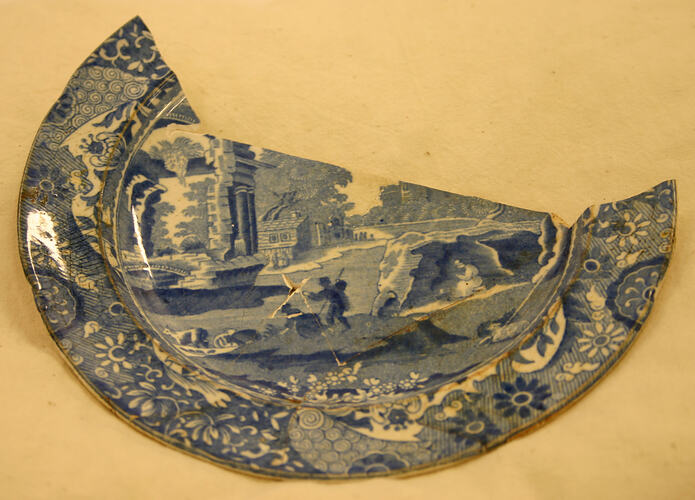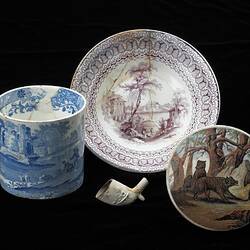Summary
This plate was reconstructed from seven fragments that were excavated at one of the digs on the Commonwealth Block between 1988 and 2003. It is a Copeland Late Spode plate and was manufactured between 1847 and 1867 in Stoke-on-Trent, Staffordshire, England. The pattern is known as 'Italian' and was the most common pattern, other than 'Willow', in 19th century design. Much English blue and white transfer printed pottery showed similar scenes, with people and a river or lake, and ruins.
Uncovering past food practices.
Of all the archaeological material uncovered in the Little Lon excavations, the remnants of eating and drinking are the most numerous. Broken plates, bowls, cups and cutlery were thrown into rubbish piles with smashed jars that once held jam and pickles, and jugs that held water or cordial. Shells from oysters, abalone and coconuts were tossed in with bones from mutton, beef, rabbit and pork. Pips and seeds from fruit and vegetables were also added to the piles. These objects offer clues to the food consumed by residents of Little Lon, and are important in the rediscovery of a people, place and time long vanished.
Physical Description
Blue and white bread-and-butter plate, rural scene Broken, 7 pieces 16 cm diameter Manufacturer: Copeland, Late Spode, 1847 - 1867Transfer-printed plate, marked 'Copeland Late Spode', was made in Stoke, Staffordshire, between 1847 - 1867Pattern
More Information
-
Collection Names
-
Collecting Areas
-
Acquisition Information
Transfer from Heritage Victoria, Industry Superannuation Property Trust, 03 May 2005
-
Manufacture Name
-
Manufacture Date
-
Manufacturer
W.T. Copeland, Stoke-on-Trent, Staffordshire, England, Great Britain, 1847-1867
-
Inscriptions
On base: 'Copeland Late Spode' (TP).
-
Context Number
02/22
-
Site
[CCS] Australia, Victoria, Commonwealth Block, Melbourne
-
Activity
-
Specific Activity
-
Decoration
-
Colour
Blue
-
Form
Curved Marly Rim; Flat (Base)
-
Shape
Round, Indented
-
Technique
-
Provenance
England, Staffordshire
-
Classification
-
Category
-
Discipline
-
Type of item
-
EAMC Measurements
160 (Outside Diameter)
-
References
G. A. Godden 'Encyclopedia of British Pottery and Porcelain Marks', 1991
171 Pages
-
Keywords


